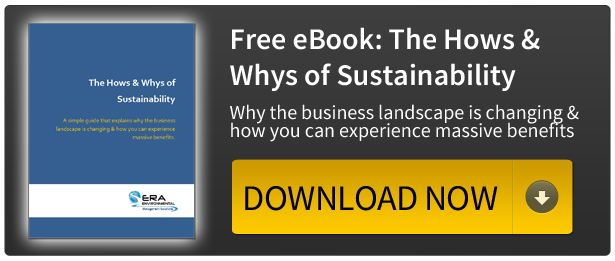
The trend towards lean business strategies has already changed the way EH&S responsibilities are handled. Does this same lean approach make sense for small to midsize businesses when it comes to sustainability projects?
A Shrinking EH&S Workforce
There’s a constant pressure in Environmental, Health & Safety (EH&S) departments to be as lean as possible: to get the most done with the fewest resources.
Over the last few years, along with evolving technologies, there’s been a shift to automate as much EH&S management as possible and to dramatically reduce the amount of time and money spent on reporting. This lean mentality has also applied to employees, as EH&S departments are shrinking and increasingly rely on just one person to take care of everything.
The fact of the matter today is that many small to midsize manufacturers in North America can only afford to hire one environmental specialist, if any. A growing number of employees in charge of EH&S are also hired to handle other responsibilities like floor supervising and training.
As environmental data management experts, we at ERA are firm believers that the enormous tasks associated with EH&S management can be accomplished by just one person using the right tools.
Adopting a lean mentality, when done right, can be one of the best ways to reduce effort and operating costs.
A Growing Demand for Sustainability
A more recent development in the EH&S management field has been an intense dedication to sustainability measures, like energy reduction, corporate social responsibility (CSR) programs, and voluntary sustainability reporting.
Although these activities and goals are closely related to environmental management, they don’t usually get completed in the course of everyday EH&S management. Most managers find themselves too busy on regulatory compliance reporting to have the time to undertake a project like Global Reporting Initiative (GRI) reporting, even if some of the information overlaps.
Both consumers and businesses are starting to demand sustainable products and services. More than ever, labor practices are coming under the microscope, as well as material toxicity, and end of life cycle management.
The reality of sustainability tracking – extra work with extra benefits – puts businesses into a tough bind: can you really stick to your lean philosophy while adding yet another responsibility onto your already busy EH&S manager’s plate?
We’re here to tell you the answer is YES. Lean sustainability can work and here’s how:
Work Smarter
Sustainability is such a broad topic that there’s room for improvements to your processes everywhere. The common examples are energy use or greenhouse gas (GHG) emissions, but you could also address other important Triple Bottom Line areas like employee safety or your engagement with the local community and nearby ecosystems.
The key is to start off by tapping into the EH&S resources you already have. If you’re looking into sustainability, then it’s likely you’re already on pretty solid ground in terms of environmental management: so the easiest and most effortless sustainability ideas will centre on tracking and improving your environmental performance.
Things like air emissions or water use are a great place to start because you won’t have to dig very deep to find all the information you need to make smart plans, since you’ll already be tracking that kind of data.
Once you’ve got a hold of the resource and time requirements of a typical sustainability goal for your business, then you can more realistically scope larger scale projects or areas that you don’t currently pay a lot of attention to in your everyday EH&S management.
The key for small and midsize companies is to take things on one at a time rather than attempting a massive and sweeping sustainability program. Find your existing strengths and capitalize on those first until you’ve gained the experience and resources that will make the big tasks that much easier.
Find Allies
The key to successfully adding sustainability to your EH&S portfolio is to find as many allies as possible. In fact, a lot of the work needed for sustainability initiatives is actually better off for engaging a larger portion of your business and outside groups - even if technically there’s just one person in charge of the project in your department.
Because sustainability is still a developing business focus (despite its skyrocketing prevalence), there’s a sea of ongoing discussions about the best practices for sustainability tracking. Importantly, there’s also a bunch of resources available to help those just starting out or those looking to take their sustainability to the next level.
The best current example of this is the GRI and its sector supplements, which outline in clear terms the things you should be tracking and reporting as part of your sustainability campaigns. Tapping into these types of resources and the larger sustainability community will help ease your work load, since many businesses ahead of yours have already tested and vetted certain best practices and systems.
It’s equally important to find internal allies that will reduce the amount of effort it will take to accomplish a sustainability goal. For example, many of today’s sustainability campaigns are heavily driven by marketing and public relations: although there’s a core of environmental improvements and efficiency at the heart of any sustainability program, it’s often savvy marketers that are generating the immediate ROI and consumer buy-in that executives love to see.
If you can develop a sustainability project alongside your marketing team, they’ll take on a great deal of the extra work and hopefully generate enough buzz with your markets to increase your available resources for the next project. For more on this, read “Is Your Sustainability Planning Wrong?: Using Easy Wins Correctly".
Remember, even if you’re just one EH&S manager in charge of an entire small or midsize business’ EH&S and sustainability: you are not alone.
Lean Where it Matters
The lean philosophy is all about doing more with less, and sustainability doesn’t need to be the exception. If you’ve already adopted a lean mentality for your EH&S management, you’ve already developed a strong data management base to build your sustainability projects off of.
And unlike EH&S management, which can often get ignored by other branches of your business, sustainability is a group effort that attracts time and resources from across departments.
Lean sustainability works because working lean doesn’t mean doing it all on your own.
This blog was co-authored by:


Tags:
Sustainability
February 18, 2013


Comments